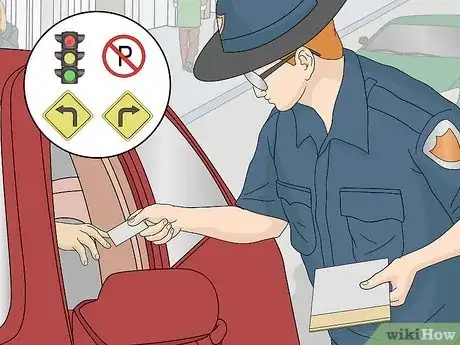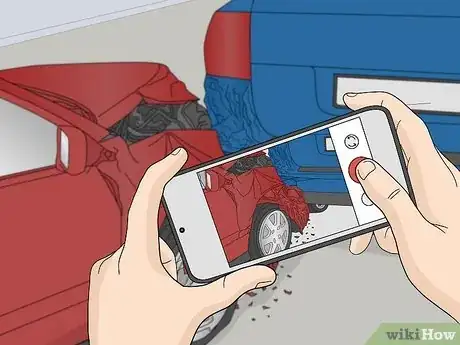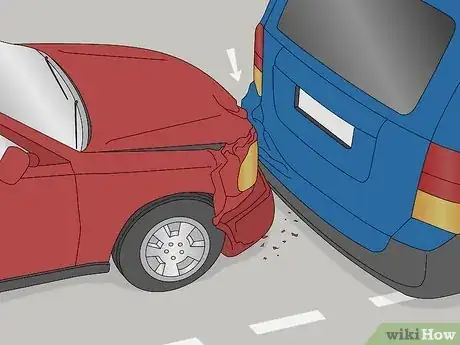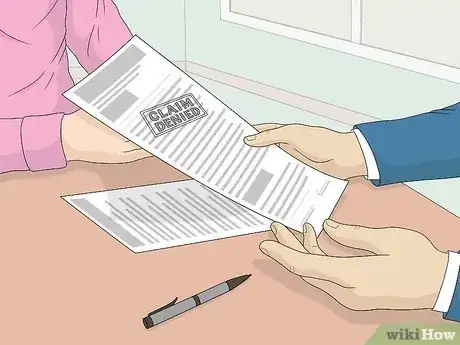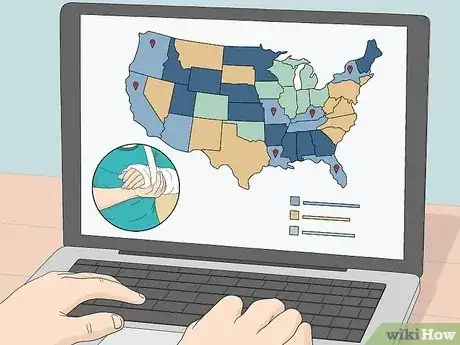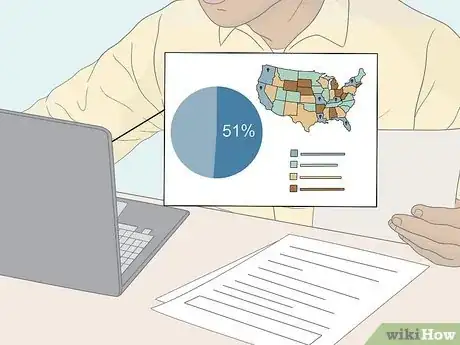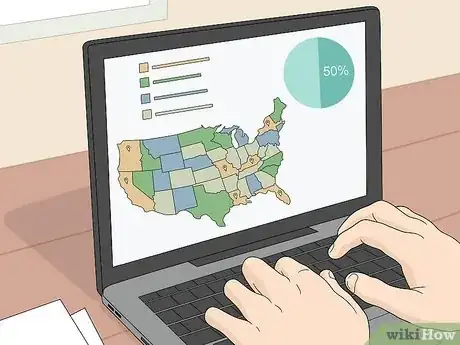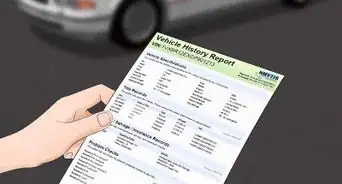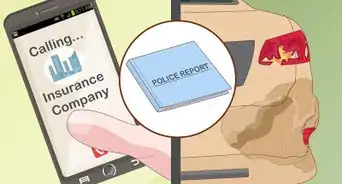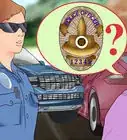This article was co-authored by Clinton M. Sandvick, JD, PhD. Clinton M. Sandvick worked as a civil litigator in California for over 7 years. He received his JD from the University of Wisconsin-Madison in 1998 and his PhD in American History from the University of Oregon in 2013.
This article has been viewed 334,476 times.
In general, the driver responsible for the accident has to pay for all damages. However, many states have complicated systems of determining fault, whereby a percentage of the blame can be assigned to each driver, resulting in different monetary obligations for each party. In most states, the drivers' insurance companies decide each driver's liability and seek indemnification from the other company to cover their insured. Insurance companies are not required to come to the same conclusions as the police regarding fault. Insurance companies have the final say in determining who they believe is at fault.
Steps
Collecting Evidence from the Accident
-
1Note any traffic citations or violations of traffic law. Any driver violating traffic law will be held largely responsible for a resulting car accident. If one of the drivers is issued a citation for speeding, running a light, or another violation, he or she will likely be at fault.[1] If no police are present to issue citations, judge for yourself whether an obvious infraction has occurred. Consult local traffic laws, as these may be different from state laws.
- Insurance companies can always choose to disagree with police findings when determining liability.
- You should always call the police to the scene of an accident.
-
2Consider evidence relevant to the accident. Police and insurance companies can rely on several different types of evidence when determining fault in an accident. Generally speaking anything relevant can be introduced as evidence.[2]
- Photos of the accident can help establish what happened and the extent of the damages.
- Witnesses statements, while less reliable, can help explain what happened. If several people corroborate each other, then this can help solidify a case.
- Police reports provide an impartial view of what happened at the scene. However, unless the police officer witnessed the accident, it is based on the evidence they collected at the accident.[3]
- Video cameras (private and public) may show what happened in an accident.
- The physical evidence from the accident will also play an important role in determining fault. This includes damage to the vehicles, skid marks, paint on a car, etc.
Advertisement -
3Decide whether the accident is the result of a rear-end collision or a left-hand turn. In most cases, a driver who hits another car from behind is at fault. Likewise, a driver making a left turn is most often blamed for any accident that results from this turn.
- Although these situations are common, they are not always the case. Make sure that you consider the full situation to make a determination of fault and not just whether the driver rear-ended another or was making a left turn.
- For example, if a driver slammed on his or her breaks without justification, that driver may be at fault if another driver rear ends him or her. Similarly, a driver making a left turn on a green arrow obviously isn’t at fault if someone else runs a red light.
-
4Record any comments made by the drivers after the accident. Police reports and insurance claims often reference one driver's (often inadvertent) admission of guilt after an accident. If one driver says something like, "I'm sorry for hitting you,” or "I didn't see you," the driver can be assigned most or all of the blame for the accident.
-
5Consult witnesses about how the accident occurred. In most circumstances, drivers will not admit blame. Witnesses, however, often have a definite opinion about fault in an accident. Record witnesses' names and phone numbers. Ask them to relate their account of the accident, including the reason why they think one or the other of the drivers is at fault.
- In situations without witnesses and conflicting information—especially regarding which driver had a green light—insurance companies (and lawyers if a hearing is applicable) is try to determine which driver is more credible based on driving record and other information.[4]
-
6Consider whether either driver was negligent before the accident. Unless the driver caused the accident intentionally, negligence is the usual legal justification for requiring one driver to reimburse another for damage caused in an accident. Negligence is defined as breaching a certain duty and thereby causing damages. In terms of an accident, this means that one driver failed to do (or not do) something that he or she should have done, resulting in an accident causing damages.
- Negligence may be an obvious violation of traffic law, such as running a red light, or a subtler failure to drive responsibly. Common examples of driver negligence include driving without headlights on at night, failing to look both ways before turning, failing to wear glasses with poor eyesight, or not using a blinker at a turn.
Applying the Evidence to Determine Fault
-
1Determine if you live in a no-fault auto insurance state. The state you live in determines to some degree how the insurance company might assign fault. There are twelve no-fault auto insurance states: Florida, Hawaii, Kansas, Kentucky, Massachusetts, Michigan, Minnesota, New Jersey, New York, North Dakota, Pennsylvania and Utah.[5]
-
2Determine if you live in a pure contributory negligence state. In some state’s, if an injured party is even the slightest bit at fault in the accident, then he or she cannot recover any losses for his or her injuries or damages.[8]
- The few states that have pure contributory negligence laws include Alabama, the District of Columbia, Maryland, North Carolina and Virginia.[9]
-
3Research if your state has pure comparative fault statutes. In these states, if an injured person is partially at fault for causing his or her own injuries, the damages are reduced by the percentage of fault.[10]
- States where this applies include Alaska, Arizona, California, Florida, Kentucky, Louisiana, Mississippi, Missouri, New Mexico, New York, Rhode Island, South Dakota and Washington.[11]
-
4Note whether your state adopts proportional comparative fault at 51%. In these states, you cannot recover any losses if you are more than 51% at fault for the accident. This means you cannot file a liability claim and lawsuit against the other driver’s negligence if you were more than 51% at fault.[12]
- These states include Connecticut, Delaware, Hawaii, Illinois, Indiana, Iowa, Massachusetts, Michigan, Minnesota, Montana, Nevada, New Hampshire, New Jersey, Ohio, Oregon, Pennsylvania, South Carolina, Texas, Vermont, Wisconsin and Wyoming.[13]
-
5Note whether your state adopts proportional comparative fault at 50%. In these states, an injured person who is less than 50% at fault for the accident is entitled to compensation. If you are 50% or more at fault, you are not entitled to recovery for injuries.[14]
- States that have adopted this standard include Arkansas, Colorado, Georgia, Idaho, Kansas, Maine, Nebraska, North Dakota, Oklahoma, Tennessee, Utah and West Virginia.[15]
References
- ↑ http://www.caraccidentattorneys.com/lawyer-resources/determining-auto-accident-fault.htm
- ↑ http://www.legalmatch.com/law-library/article/determining-fault-in-car-crash-claims.html
- ↑ http://www.hg.org/article.asp?id=18802
- ↑ http://www.caraccidentattorneys.com/lawyer-resources/determining-auto-accident-fault.htm
- ↑ https://www.allstate.com/tools-and-resources/car-insurance/no-fault-insurance-cover.aspx
- ↑ https://www.allstate.com/tools-and-resources/car-insurance/no-fault-insurance-cover.aspx
- ↑ https://www.allstate.com/tools-and-resources/car-insurance/no-fault-insurance-cover.aspx
- ↑ https://www.freeadvice.com/legal/car-accident-determining-who-is-at-fault/
- ↑ https://www.freeadvice.com/legal/car-accident-determining-who-is-at-fault/
- ↑ https://www.freeadvice.com/legal/car-accident-determining-who-is-at-fault/
- ↑ https://www.freeadvice.com/legal/car-accident-determining-who-is-at-fault/
- ↑ https://www.freeadvice.com/legal/car-accident-determining-who-is-at-fault/
- ↑ https://www.freeadvice.com/legal/car-accident-determining-who-is-at-fault/
- ↑ https://www.freeadvice.com/legal/car-accident-determining-who-is-at-fault/
- ↑ https://www.freeadvice.com/legal/car-accident-determining-who-is-at-fault/
- ↑ http://www.hg.org/article.asp?id=18802
About This Article
To determine who is at fault in a car accident, look at all of the evidence you have from the scene, such as photos of damage, witness statements, and dash-cam or surveillance footage. Take note of any traffic violations either party made, like running a red light, not using a blinker when turning, or driving without lights at night, which will tell you who was at fault. Decide if the accident was a result of a rear-end collision, where the driver who rear-ended the other one is usually to blame. In the same way, if a driver is taking a left-hand turn and hits you, they will often be found at fault. Try to record any comments made by the driver, such as, "I'm sorry for hitting you," or, "I didn't see you there," since this can help you demonstrate that it was their fault. For more tips from our Legal co-author, including how fault is determined in different states, read on!
